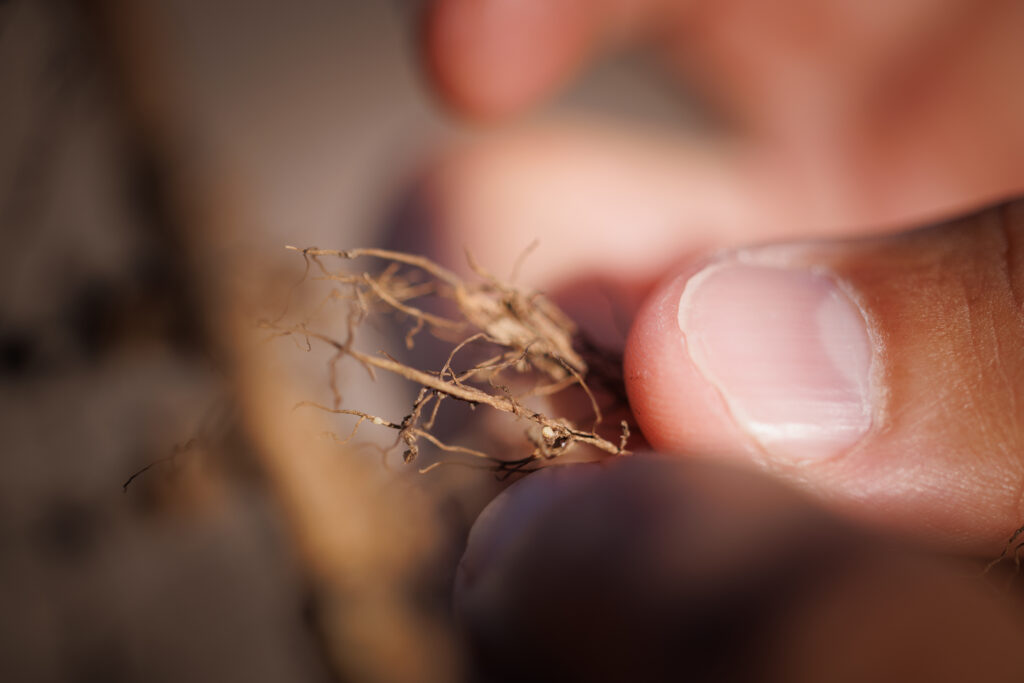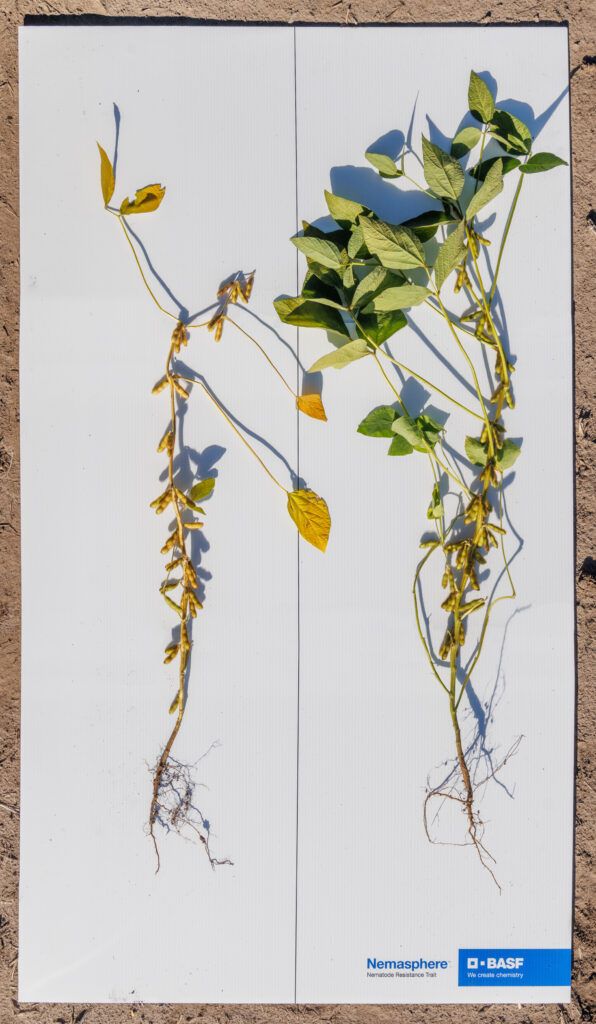
BASF’s Nemasphere is the first new soybean cyst nematode trait in more than 60 years.
Growers and researchers have been battling Soybean Cyst Nematode (SCN) for decades. Most growers don’t even know they have SCN until it’s too late and once it’s in the soil, it’s there to stay. BASF is making waves with its latest trait development: Nemasphere, which they describe as an advanced solution for combating the pest. SCN is the number one yield-reducing pathogen for soybeans around the world. At the forefront of this breakthrough are Michael McCarville and Julia Daum, two experts from BASF who have been dedicated to solving this silent yet devastating issue. Their passion for sustainable agriculture and novel pest management methods has led to the development of a trait that promises to reshape how farmers tackle nematode infestations.
BASF’s launch materials state SCN has stolen billions in yields and profits from farmers over the past five decades. “SCN is abundant in soybean fields. It steals yields, profits, and world-feeding potential every day,” McCarville says. “2024 marks the 50th year that SCN has been the number one disease issue in the United States — a sobering milestone.”
Researchers across the seed sector have spent decades studying ways to combat SCN, but progress has been limited, leaving growers dependent on outdated, increasingly ineffective native resistance traits. This year, BASF has stepped forward with a potentially game-changing solution.
Exposing the Hidden Threat
SCN is no small problem. As McCarville, BASF’s trait development manager, explains, “Soybean cyst nematode is the number one yield-reducing pathogen of soybean in the United States, and really, worldwide.”

The pest siphons an estimated $1.5 billion from U.S. farmers every year.
“If you add up pathogens two through five, they equal what SCN does,” he notes. “A lot of the yield loss that we see from soybean cyst nematode is kind of silent. The crop looks pretty good. You don’t see any obvious above-ground symptoms, but you can have yield losses up to 20% in that range.”
For farmers, this means they may not even know they have a problem until the damage is done. By then, reclaiming lost ground is an uphill battle. McCarville’s goal isn’t just to help growers identify SCN — it’s to empower them to halt its impacts before it starts.
“We’re looking at solving problems before they become obvious to the farmer,” he states, highlighting the need for proactive, reliable solutions.
The Long Road to Innovation
Julia Daum, a BASF program leader in trait research, has been on the frontlines of this quest for almost two decades.
“I remember thinking that if we could come up with a novel solution for soybean cyst nematode, it would be a game-changer for the farmer,” she recalls.
From the beginning, Daum and her team saw potential in novel cry proteins, which had already proven effective for insect control. She sought a similar protein that would work on nematodes.
“It took nearly 10 more years for me to discover the novel Cry14 protein that would form the basis of Nemasphere,” Daum says, recalling the many challenges they faced.
The Cry14 protein, a single-locus trait, disrupts nutrient uptake in nematodes, ultimately killing them and protecting the soybean plant. Daum presented her findings to McCarville in 2016, sparking a new chapter in the development process.
“When I met Julia back in 2016, I had already been working on SCN for almost a decade,” he says. “I had worked eight years at this and made absolutely no dents.”
Crafting a Comprehensive IPM Solution
With Nemasphere, BASF asserts they are not just offering another trait; but introducing the first and only biotechnology trait specifically for SCN control.
“Today, traits are really the best way to manage nematode problems,” McCarville explains. “Yet, relying solely on native traits isn’t enough. BASF’s approach combines transgenic Cry14 protein with native SCN resistance traits, creating a dual defense designed to protect against yield loss while maintaining yield potential.”
McCarville underscores that this innovation stands to reshape the industry.
“This provides a roadmap for how you can do that,” he says.

In fact, BASF has already conducted more than 200 field trials across North America. The results show an average yield enhancement of 8%, which could grow as SCN resistance to native traits continues to increase.
“Not only did we have something that was going to address yield, but we have something that’s going to reduce risk for [farmers],” he adds, reflecting on a successful trial in Iowa back in 2017.
Market Launch and Global Impact
BASF’s Nemasphere is slated for commercial release in 2028, pending regulatory approval. The trait promises to be versatile, allowing breeders to integrate it into various high-yielding varieties without compromising agronomic performance. Additionally, Nemasphere will be stacked with the Enlist E3® herbicide tolerance trait, giving farmers a multifaceted tool to optimize soybean productivity.
The potential for global impact is substantial. SCN is not just United States issue; it’s the number one yield reducer for soybeans worldwide.
“In Latin America, they have a lot of issues with soybean cyst nematode, too,” McCarville says. “This provides a way for them to get to some sustainable management for their key nematode issues in South America.”
By tackling SCN head-on, McCarville says Nemasphere offers a valuable blueprint for nematode control across other crops.
Subhead: Innovation and Perseverance
For both Daum and McCarville, the road to Nemasphere has been a long but rewarding journey.
“It’s really fulfilling to know that what I’ve been working on is actually going to make a difference,” Daum says.
Working in the lab, she could only hope for such an outcome. Now, with Nemasphere poised for market launch, she knows that the project will have a tangible impact.
“Most people in research hope their work will have an impact, but to see it progressing to this point is huge,” she says.
Bryan Perry, BASF U.S. Head of Seeds and Traits, underscores the company’s farmer-first approach, which has been central to Nemasphere’s development.
“When someone asks me, ‘who’s your customer?’ I’ll always answer that my ultimate customer is the farmer,” he says.
Perry’s perspective was shaped by his father-in-law, a dairy farmer and Cooperative Extension agent. “He told me something I always have to keep in mind is helping our farmers make more money. He said if we’re helping them do that, we’re doing the right thing.” This philosophy is woven throughout BASF’s efforts, especially when it comes to innovation.
Subhead: Advice for Innovators
As they look toward Nemasphere’s launch, both Daum and McCarville offer advice for those in the thick of long-term projects.
“Innovation is undefeated,” McCarville says, referring to a favorite quote. “New solutions for old problems are always going to be a market-winning strategy.”
He emphasizes the importance of resilience, acknowledging that innovation can be slow and sometimes arduous.
“At the end of the day, the customer desires those innovative solutions, and that’s what we’re really working towards,” he adds.
Daum encourages a mindset of open-mindedness and flexibility.
“We started with the goal of finding a silver bullet,” she says, “but what we found was that if we combined cry proteins with native traits, that’s a solution — and a really good one.”
Her experience illustrates the value of thinking outside the box and being willing to pivot as new information emerges.
With the imminent commercial launch of Nemasphere, BASF is already looking to the future. Daum is excited about the ongoing research that will build on Nemasphere’s foundation.
“I’m very involved and excited to be working on the next generation of traits,” she says.
This long-term view is critical to ensuring that solutions like Nemasphere can continue to adapt to evolving agricultural challenges.
McCarville is equally enthusiastic about raising awareness among farmers as the launch approaches.
“People get fatigued about hearing about a problem without a solution,” he says. “Here’s a way to re-engage and inject some energy into that conversation.”
As the team works toward the 2028 launch, they remain committed to their ultimate goal: delivering a sustainable, effective tool that will empower farmers to reclaim lost yields and build resilience against future challenges.
BASF’s Nemasphere represents a bold new chapter in soybean pest management. With a dedicated team, cutting-edge technology, and a commitment to sustainable agriculture, this innovative trait is set to change the landscape for soybean farmers not only in the United States but around the world. As Daum and McCarville look toward the future, they see a world where the battle against SCN is not just manageable but winnable — one trait at a time.
The post Unmasking a Silent Soybean Yield Thief appeared first on Seed World.



